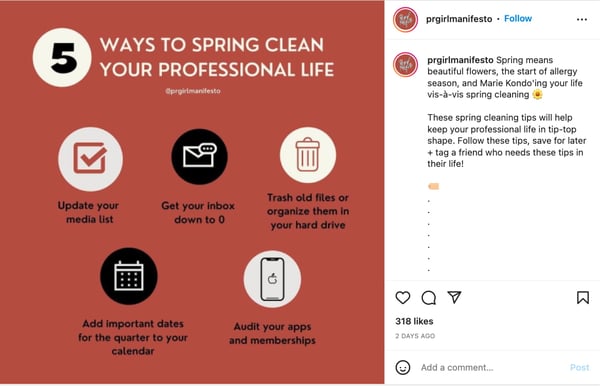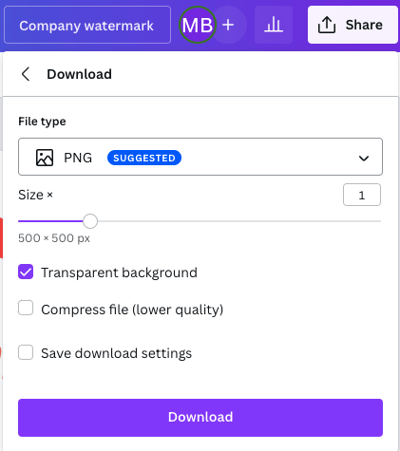
Imagine you spend hours working on a cool graphic for a social media post. You finally get it just right and post it on social media. The next day, you log on and see that someone else has posted your image without your authorization and is purporting your work as their own.
Creating a watermark would help protect you against this common issue and help you with your brand recognition. In this article, you’ll learn about the type of watermarks that exist and how to create your own.
What is a watermark?
A watermark is a message that is superimposed onto another image. It’s a common practice among photographers, videographers, and brands to protect their content from being stolen and easily identifiable.
Typically, a watermark has its opacity set to 50% or less. If it’s too bold and opaque, it can distract viewers from noticing other details in the content. However, if it’s too transparent, it will easily be ignored.
The opacity will depend on the type of image you have and its purpose. For instance, photographers and videographers will go for a higher lower opacity because every detail of their image matters. They’re also more likely to place the watermark at the bottom of the corner of an image.
For a brand sharing content marketing tips, the watermark will likely be very opaque and placed prominently on the asset for easy recognition.
Types of Watermarks
There are two types of watermarks: visible and digital. They’re used for different purposes by different users.
A visible watermark is what most people think of when we use the term. It refers to a visible stamp, usually a logo, phrase, or pattern, that has been superimposed on an image. Content creators use this type most frequently to prevent theft and help their brand recognition.
A digital watermark, on the other hand, isn’t visible to the naked eye. Instead, the watermark is embedded into the data of the image. While this can also be used by content creators, it’s used more often by banking institutions and news organizations to authenticate media and identify its source.
Why are watermarks important?
Online, particularly on social media, content creators and brands don’t have many reliable resources to protect them against theft. Someone can easily take a screenshot or screenshot work from another user and post it as their own.
While most social media sites do offer reporting tools, there is still a lot of work to be done to protect users online against copyright infringement. One of the few social channels where repercussions are seemingly swift is YouTube, where the use of music and videos is closely moderated.

As a result, a watermark can help you protect your work. It’s not foolproof but it does offer a layer of security.
Brand Recognition
On social media, content can take off at any time.
If you’re lucky enough to go viral, it’s likely that other pages will repost your content. You want to make sure your content has something identifiable to lead users back to your page.
Reaching a larger audience is also a great opportunity to get your brand out there and build your brand recognition.
Watermark Examples
Adobe
To prevent the illegal download of its creative assets, Adobe adds watermarks to every image a user previews. 
Notice that they use two types of watermarks: One located across the entire image in gray with the words “Adobe Stock” and another on the bottom left corner in black.
This allows users to easily preview the image without using it before purchase.
Buzz Media Agency
This media agency uses watermarks in an Instagram post to share their work without the risk of another user stealing it without proper attribution.

You’ll notice that their watermark is their logo, which makes it easy for users to find them if the image is shared on the platform or anywhere else.
In addition, it’s noticeable without taking the attention away from the other elements in the image.
PR Girl Manifesto
This brand uses a more modern approach to watermarking, one that many companies leverage when posting engaging, shareable content on social media.

In this case, there are a few things that are different from your average watermark:
- The opacity is at 100%, making it very visible. However, it’s balanced by small font size.
- It’s not a logo or pattern, it’s the page’s Instagram handle instead.
When marketing content on social media, watermarking this way is always a good idea. It keeps your brand at the center and makes it easy for users to find your profile.
How to Create a Watermark
There are many ways to create a watermark. As such, the method you use will depend on the tools you have available and the type of asset you want to watermark.
The most popular tools to create a watermark are:
Because Canva is the most accessible option, let’s cover how to make a watermark with this tool.
-
Visit Canva.com and create an account.
-
Select a template type or create a custom template.

-
Create your watermark and select your desired opacity.

-
Once you’re done creating your watermark, click “Share” on the top right corner. Then, select “Download.”

-
Check “transparent background” and download your watermark.

Note: This feature is only available on Canva Pro. To complete this step for free, download the image then visit removebg.com to upload your image and remove the background for free. -
Use your watermark on videos, images, and other content.

There you have it! Creating a watermark is a preventative measure that can help you both protect your creative assets and help you build brand recognition.





